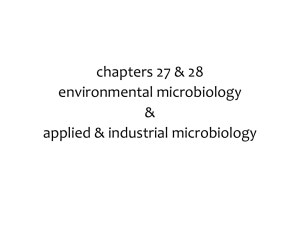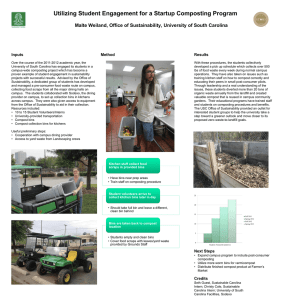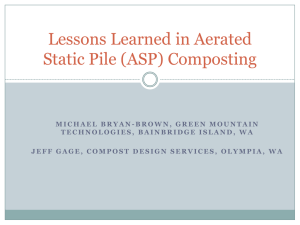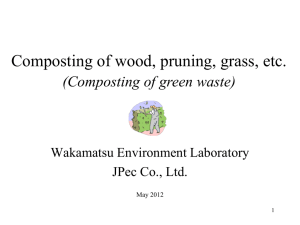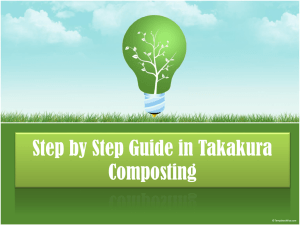Aerobic Composting - IN Rural Community Assistance Program
advertisement
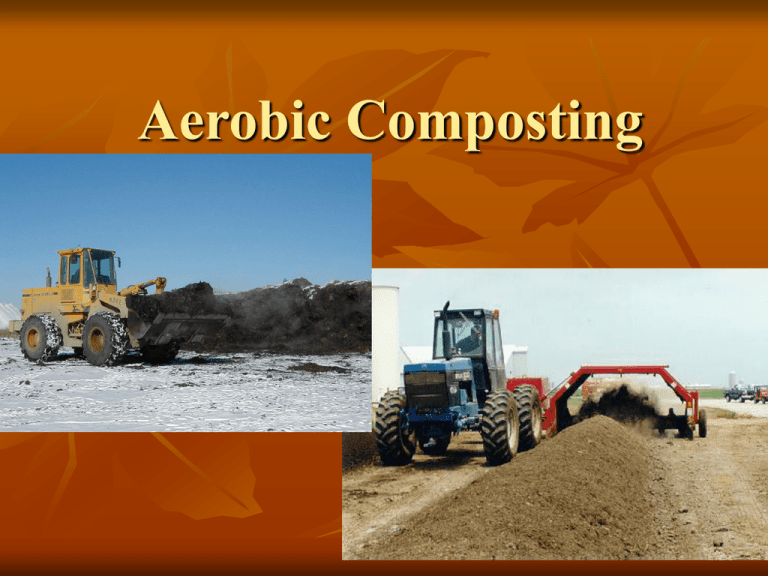
Aerobic Composting Presentation 7: The Composting Toolkit Funded by the Indiana Department of Environmental Management Recycling Grants Program Developed by the Indiana Rural Community Assistance Program RCAP So Let’s Talk About Composting . . . Compost NOUN OR VERB? BOTH! The verb: “Composting” is the process by which microorganisms break down waste and turn it into a valuable product. The noun: This end product is referred to simply as “compost.” Types of Composting: Aerobic or Anaerobic? We are talking is AEROBIC composting. That is, composting in the presence of OXYGEN. Microorganisms decompose organics aerobically (with oxygen) under carefully controlled conditions to produce finished compost. Anaerobic decomposition is what occurs in a landfill with Carbon Dioxide, Methane, and Leachate being three major products. Compost Happens Aerobic Composting Composting is part science and part art. There is no one “correct” recipe for aerobic composting. You will be introduced in this unit to the basics of aerobic composting and “optimal” conditions, but you need to always keep in mind that flexibility is the key to successful composting. Aerobic Composting: Key Components Air Water Compostable Materials Carbon to Nitrogen Ratio Surface Area Temperature pH Other Variables Aerobic Composting: Optimal Composting Conditions Oxygen: >5% Moisture Content: 40-60% Carbon to Nitrogen Ratio: 30 to 1 Shredded Materials Over Chipped Materials To Maximize Surface Area Temperature: 90-140 Degrees F pH: 6-8 Other Variables Aerobic Composting Air: Optimal composting when oxygen is greater than 5% The air we breath is 21% oxygen Right picture is testing for oxygen level within the compost pile Aerobic Composting Air: The microorganisms that perform the composting process require oxygen to survive. Because the compost pile provides a plentiful food source for these microorganisms they quickly multiply. This is beneficial to the composting process, but there can become too many microorganisms for oxygen supplies within the pile. Oxygen statically flowing into the pile will be far less than the oxygen being consumed by the microorganisms. Thus oxygen levels will begin to fall within the pile from the 21% oxygen level in the surrounding atmosphere. Below 5% oxygen level the microorganisms will begin to be impaired Regular turning is required of a windrow compost pile restores oxygen to the compost pile and helps to ensure that oxygen levels do not fall below 5% Aerobic Composting Water An ideal moisture content is between 40-60%. Composting microorganisms need a wet environment. >60% is too wet, water will take up too much pore space required for proper air diffusion. <40% is too dry, decomposition rates will progressively slow the drier the pile. Aerobic Composting Water: Here in Indiana it is unusual to have a pile that is too dry, you are more likely to have a pile that is too wet. A pile that is too wet can be turned on an increased schedule until moisture contents fall back into desired ranges. In a case where the pile is too dry water may be added or the pile may be reshaped to allow more water to enter the pile during the next rainstorm. Aerobic Composting Water: Shaping the compost pile according to moisture content needs is clearly an example of the “art” of composting A concave shape helps to trap water whereas a peak shape helps to shed water. Aerobic Composting Carbon to Nitrogen Ratio Also commonly called the C:N ratio or the brown to green ratio This is because organics high in carbon tend to be brown (wood and old leaves being two examples) Organics high in nitrogen tend to be green (grass clippings and food waste being two examples) An optimal carbon to nitrogen ratio is 30:1 Too much carbon slows the composting process Too much nitrogen “supercharges” the composting process and runs the risk of going anaerobic or off-gassing nitrogen compounds—both causing negative odors Aerobic Composting Common Carbon to Nitrogen Ratios: High Nitrogen Materials: Activated Sewage Sludge: 6:1 Humus: 10:1 Vegetable Food Waste: 15:1 Digested Sewage Sludge: 16:1 Grass Clippings: 19:1 Cow Manure: 20:1 Horse Manure: 25:1 Green Leaves: <30:1 Aerobic Composting Common Carbon to Nitrogen Ratios: High Carbon Materials: Fruit Food Wastes: 35:1 Typical Brown Leaves: 40-80:1 Foliage: 40-80:1 Corn Stalks: 60:1 Pine Needles: 60-110:1 Straw: 80:1 Bark: 100-130:1 Paper: 150-200:1 Wood and Sawdust: 300-700:1 Aerobic Composting Steaming compost during turning is a sure sign that temperatures are being maintained. An indicator that the oxygen levels, moisture content, and the C:N ratio are in balance. Aerobic Composting Surface Area: Greater surface area accelerates decomposition. There are two primary ways to increase surface area: Smaller particles size Shredding materials over chipping materials Aerobic Composting Temperature: Exothermic microorganisms decompose waste and in the process give off heat An optimal temperature range is 90-140 degrees F Below 90 degrees the composting rate slows substantially Above 140 degrees the microorganisms have difficulty functioning and the pile runs the risk of spontaneous combustion Aerobic Composting Temperature: A compost pile’s temperature is a balance of the heat produced by the respiration of the microorganisms offset by the heat lost through surface cooling In the winter larger pile sizes may be required to offset heat losses In the summer more frequent turning and smaller pile sizes may be required to offset excess heat Aerobic Composting Temperature One other important function of maintaining high temperatures in a compost pile is weed seed destruction and pathogen destruction. Example: Salmonella destruction requires: 20 minutes at 140 degrees F Or 1 hour at 131 degrees F Aerobic Composting Temperature: Testing temperature within the compost pile Aerobic Composting pH Decomposition occurs most efficiently between pH 6 and pH 8. During the initial stages of decomposition, organic acids are formed that, under normal conditions, are immediately consumed by microorganisms. Without enough oxygen in the pile, these acids will not be converted as quickly. Aerobic Composting Other Variables: There may be other variables of concern as a composting operation is refined to make products of a specified composition. These variables, which are beyond the scope of this manual, include mass balance, rate of respiration of the microorganisms, mixing and agitation of the pile, nutrient balance, inoculation, wetting agents, cation exchange ratio, pathogen destruction, wind velocity, and specific elemental composition. Windrow Composting Most common method of yard waste composting in the United States Generally a “row” of material is composted, usually about 10-25 feet wide, 6 feet high, and as long as 150 feet. Windrow composting has been shown to be highly cost effective. Windrow Windrow Windrow Turner Windrows – Optimum Composition Shredded and screened organics Moisture content: 40-60% Balanced 30:1 Carbon to Nitrogen ratio Frequent turning: Frequent turning keeps the pile aerobic and reduces odor Volume and Weight Reduction With optimal composting a volume reduction of up to 75% can be achieved and a weight reduction of up to 50% can be achieved. For high water content materials this volume and weight reduction can be as high as 90%. Single Biggest Problem: ODOR Reasons #1 Reason is Lack of Oxygen Also . . . Out of balance C:N Ratio And . . . Excessive wetness Odor control is discussed in more depth in the “Ongoing Operations” section. Other Problems Pathogens destruction Litter and contaminants (plastic bags, heavy metals, pesticides) End product quality Windrow Composting Trouble Shooting Symptom: Pile has a bad odor Symptom: Center of pile is dry Problem: Not enough water Solution: Moisten material while turning pile Symptom: Compost is damp and warm Problem: Not enough oxygen Solution: Turn pile daily until odor is gone Problem: Pile too small or needs more nitrogen Solution: Collect more material and mix the pile. If still not heating add more nitrogen rich materials. Symptom: The pile will not heat up Problem: Lack of nitrogen Solution: Mix in a nitrogen source such as grass clippings, fresh manure, or fertilizer Windrow Composting - Overall Capital costs generally low Operating costs generally low Land requirements high Control of Air limited unless forced aeration is used Operational control turning frequency, amendment, or compost recycle addition Sensitivity to cold or wet weather sensitive unless in housing Control of odors depends on feedstock, potential largearea source Potential operating problems susceptible to adverse weather Windrow Composting - Conclusion Most commonly used composting technique in Indiana and Nationally Uses aerobic microorganisms to breakdown woody, yard waste, and food waste products into a useful “compost” end product When compared against the capital costs of other MSW management techniques, it is very cost effective QUESTIONS? Thank You! Additional Questions, Comments, or You Think You Have A Potential Pilot Community Please Feel Free to Contact Me: Mark W. Davis Technical Assistance Provider Rural Community Assistance Program Office: 1-800-382-9895 Wireless: (812) 320-0720 E-mail: mdavis@incap.org



